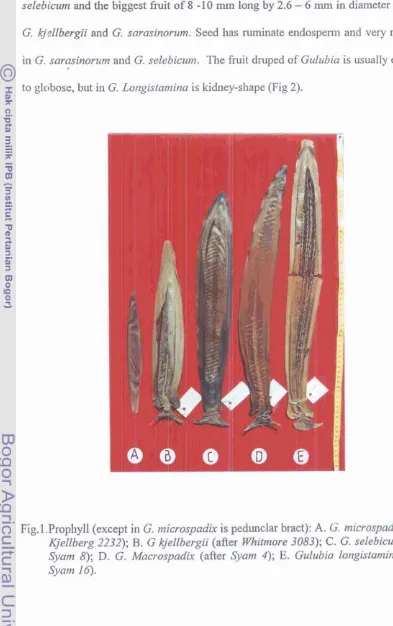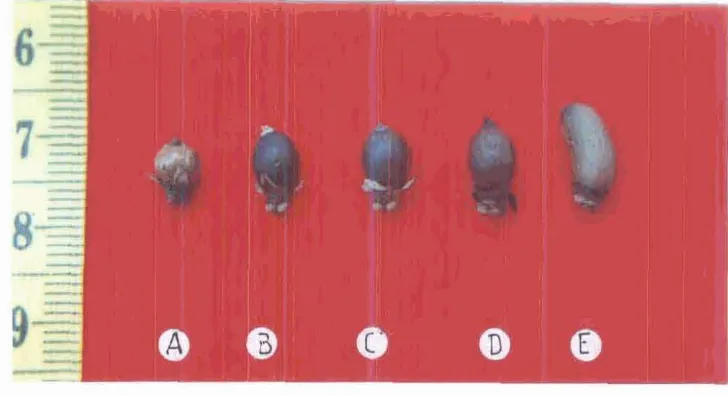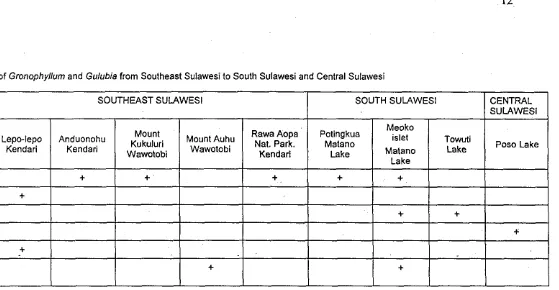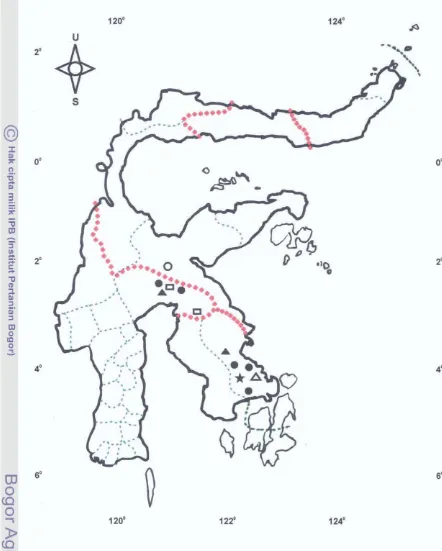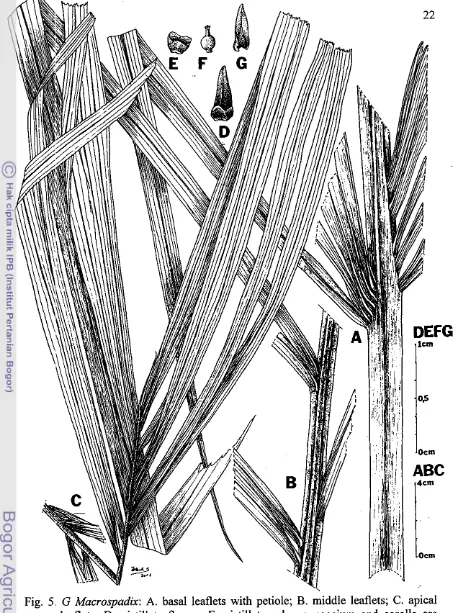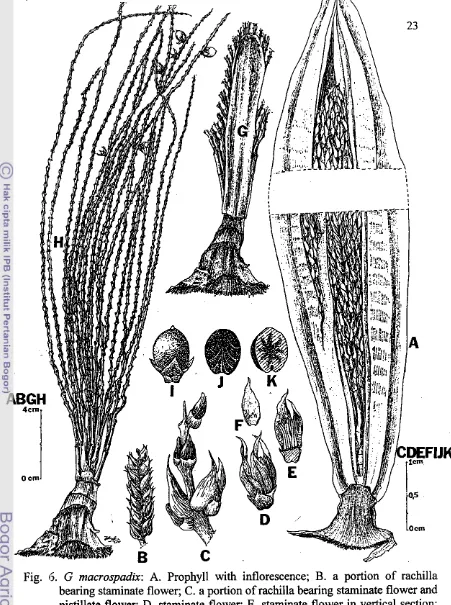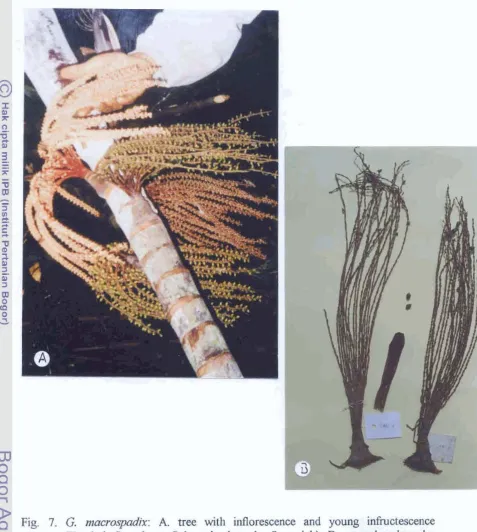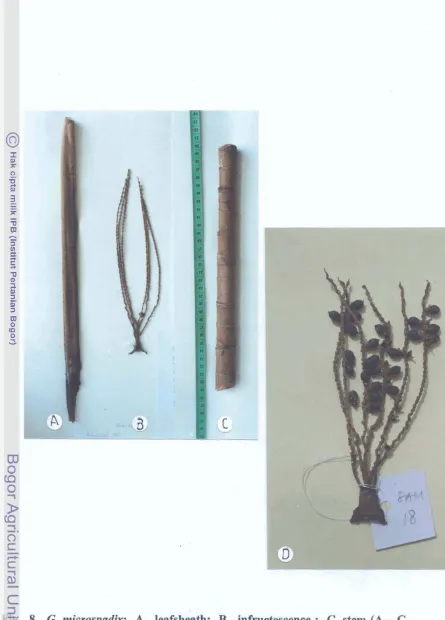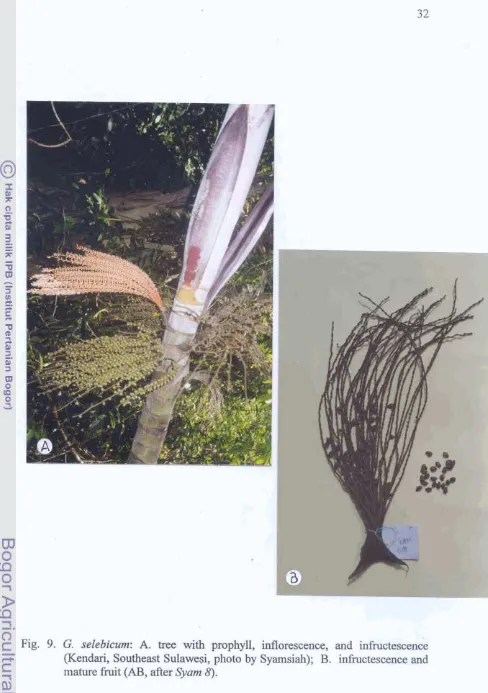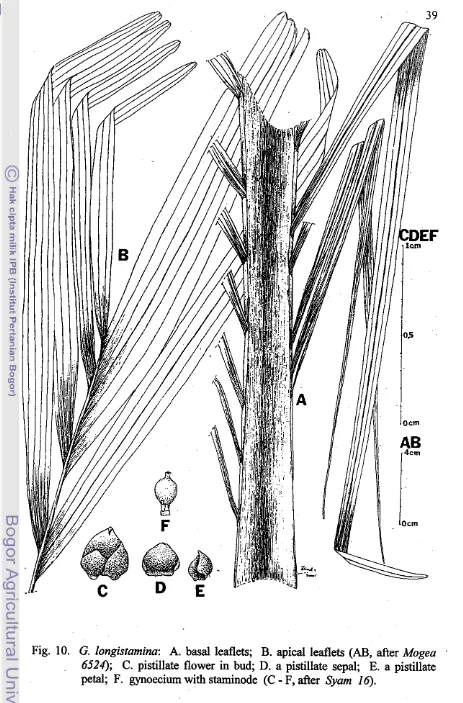GRONOPHYLLUM
AND
GULUBIA
(PALMAE)
IN SULAWESI
POST GRADUATE PROGRAM
BOGOR INSTITUTE OF AGRICULTURE
ABSTRACT
Revision on Gronophyllum and Gulubia in Sulawesi has been done. This research is based on morphological characters of herbarium specimens from Herbarium Bogoriense, Bogor, and living plants from some areas forest in Sulawesi. The result shows that there are five species of GronophyNum and one species of Gulubia in Sulawesi. Four species of Gronophyllum are known previously namely:
ABSTRAK
SURAT PERNYATAAN
Dengan ini saya menyatakan bahwa Tesis yang berjudul :
"Gronoplzyllum and Gulubia (Palmae) in Sulawesi"
Adaldh benar hasil karya saya sendiri dan belum pernah dipublikasikan.
Semua
sumbe:r data dan informasi yang digunakan telah dinyatakan secara jelas dan dapat diperilcsa kebenarannya.
Bogor, 18 Januari 2002
GRONOPHYLLUM
AND
GULUBZA (PALMAE)
IN SULAWESI
SYAMSIAH
A Thesis Submitted for the Degree of Master at
Post Graduate Program Bogor Institute of Agriculture
POST GRADUATE PROGRAM
BOGOR INSTITUTE OF AGRICULTURE
Thesis tit e : Gronophyllunz and Gulubia (Palmae) in Sulawesi
Name Syamsiah
Reg. Number : 98279
Study Program Biology (Plant Taxonomy)
Approved By:
Supervisor Committee
(Prof Dr. Ir H. Edi Guhardja,M.sc.) Supervisor
(Dr. Johanis Palar Mogea) Supervisor
Chair Person Study Program post graduate program
GY54
2(Dr. Ir. Dcdy Duryadi Solihin) afrida Manuwoto,M.Sc.)
Day of graduation :
1
8
JAN
m2
CURRICULUM VITAE
Syamsiah was born in Enrekang, South Sulawesi on 12 Desember 1962, the ninth daughter of nine children from father Rangan and mother Dongi. She was
graduated from Elementary School in 1975, Junior High School in 1979, and Senior High School in 1982, all in South Sulawesi. She was graduated from the Department of Biology, Faculty of Mathematics and Sciences IKIP Ujung Pandang in 1988.
Since March 1" 1989 she has been appointed as a lecturer at the Department of Bic~logy Haluoleo University, in 1998 she has registered as a student at the post
Graduate Program of the Bogor Institute of Agriculture. Since May 1999 she has appoirded at the Department of Biology of the Faculty of Mathematics and Sciences
TABLE OF CONTENTS
Page LIST OF TABLE
...
LIST OF FIGURES
...
...
INTRODUCTIONRESE.4RCH AND METHODOLOGY
...
RESULT AND DISCUSSION...
General Part: Morphological character
...
Habit ... Leaves...
...
IndumentumInflorescence
...
Infructescence...
Geographical Distribution...
Special Part: Taxonomy...
Generic Description of Gronophyllum...
Key to species of Gronophyllum...
Species Description of Gronophyllum. .
...
G
.
kjellbergz~...
G.
macrospadix...
G . microspadix...
G . sarasinorum ...G
.
selebicum...
Generic description of Gulubia.
.
...
Species description of Gulubia...
G
.
longistamina...
INDEX
OF EXAMINED SPECIMENS...
ACKNOWLEDGEMENTS
I would like to express my gratitude to my supervisors Prof Dr Ir. Edi Guhardja, M.Sc. and Dr. Johanis Palar Mogea for their advice, guidance and encouragement throughout my study.
My thanks also to Prof. Dr. Ir. Sjafiida Manuwoto, M.Sc., Director of the
Graduate School Bogor Institute of Agriculture; Dr. Irawati, Head of Herbarium Bogoriense for granting to conduct research and providing some facilities.
My gratitude to Dr. John Dransfield of the Royal Botanical Garden Kew for
sharing his knowledge and introducing to the miracle world of Palms; Dr. Ary P. Keim, M.Sc., who provided some literatures which are not available in Indonesia.
I would like to thanks to all graduate students of Plant Taxonomy IPB 1998, especially Dra. Tuti Djanvaningsih, M.Si. for valuable discussion. I appreciate to Ir. Himmxh Rustiami, M.Sc. and Dr. Harry Wiriadinata for suggestion, advice and
criticism.
Special thanks to my husband Azis Andawi, SE., both my parents, my sons and my daughter, my sisters and my brother for giving their moral support, financial
LIST OF TABLE
Page
Distribution of Gronophyllunz and Gulubia from Southeast Sulawesi to South
LIST OF FIGURES
Page
...
Prophyll 9
...
Fruit 10
Distribution map of Gronophyllum and Gulubia in Sulawesi
...
13. .
...G
.
kjellbergzz 20G
.
macrospadix ... 22...
G
.
mic. pospadix 28...
G
.
sele bicum 32INTRODUCTION
GronophyNum consists of 33 species which are wide spread in Sulawesi,
Moluc:cas, New Guinea, Bismarck Archipelago, and Australia. While Gulubia
consists of 9 species which are wide spread in Moluccas, New Guinea, Bismarck Archipelago, Solomon Island, Australia, New Hebrides, Fiji, and Palau. They can be found in various habitats from the lowland at sea level to montane mossy forest and
montane tropical rain forest, as undergrowth palm to emergents, on variety of rocks including serpentine and limestone (Uhl and Dransfield, 1987). So far for Indonesia,
this gt:nus has not been widely observed both at the aspect of taxonomy and its use. Groncphyllum, especially its red-trunk of 1.5 cm in diameter, has been utilized as
weapon. Commonly, Ambonese community utilize its trunk for roof, and in New Guinea its used for house construction (Heyne, 1987). The author observed that
vi1lagc:r community of Kendari, Southeast Sulawesi, used its trunk for floor and wall
of houses. Its innermost frond is edible as vegetable and its liquid can be sucked before the plant is bearing fruit. Its fruit can be used as a substitution of Areca-nut for
betel-chewer, because their husk and core have mostly the same substance. This plant
can allso be used as an ornamental plant. According to Essig (1982), trunk of Gulubia can be used for floorboards and side panels of houses in New Guinea.
Gronophyllum was firstly described by Scheffer (1876) with Gronophyllum microt:arpum from Ceram as its type, while Gulubia was firstly described in 1885 by
family of Arecaceae (Palmae), subfamily of Arecoideae, tribe Areceae and subtribe
Arecinae (Uhl and Dransfield, 1987). In 1877 Beccari classified Gronophyllum
into subgenera of Nenga consisting three species, namely: N. pinangoides, N. affinis
and
A!
selebica. The latter species originally come from Kendari, Southeast Sulawesi. In 1885, Beccari reclassified the sub genera Gronophyllurn as a genera again and added four genera, namely: Nenga, Adelonenga, Leptophoenix and Gronophyllum. GronophyNum was represented by G. microcarpum Scheff. from Ceram and G. selebicum Becc. from Sulawesi. Burret in 1934 described one species, namely: G. mk:rospadix from Sulawesi. In 1936, Burret described another two species from Sulawesi, namely: G. ljellbergii and 6. sarasinorum. In 1939, Burret found another on<: species, namely: G. brassii from New Guinea. In a synopsis by Essig (1982),he mentioned nine species of Gulubia and transfered Gulubia ramsayii to
Gr~?nophyllum ramsayii. It was said that Gronophyllum and Gulubia are two genera which are closely related and they can be distinguished only in the character behavior
of flower, the former is protandrous and the latter is protogynous. In 1985 Young
found one species, namely: G. apricum from New Guinea. Uhl and Dransfield (1987) described that Gronophyllum and Gulubia are two different genera, but they adcled that the distinction of these two'genera was still a problem and it was needed a
cortinued research. In 2000, Dowe and Ferrero described Gronophyllum cariosum
from Papua New Guinea. From Index Kewensis, the names species of Gronophyllum
thai. ever appeared in Malesian region are 27 species including four species from
selebicurn. It is said that four species are endemic for Sulawesi. Whereas the species of Gtilubia has nine known species, so far none is found in Sulawesi.
From the explanation above, it is clear that the distinction of concept of genera and species of Gronophyllurn and Gulubia were not been completely understood. The difficulties of research in these genera presumably due to lack of herbarium specimens especially the specimens from Sulawesi.
When
the study wasRESEARCH METHODOLOGY
Plact:s and Time of Research
The research was conducted from September 2000 to Juni 2001 in Herbarium Bogc~riense Bogor and field works have been conducted in Southeast Sulawesi and Soutl~ Sulawesi. In Southeast Sulawesi were in Lepo-lepo forest, Anduonohu forest,
Rawit Aopa Watumohai National Park, Mount Kukuluri Wawotobi, and in South Sulawvesi was in Matano Lake forest.
Materials and Methods
The materials of the research are all from existing specimens in the Herbarium
and 14 number of collection were added by the author. The previous collections
consists of 7 numbers of Gronophyllum and one collection of Gulubia. The collec.tions of Gronophyllum are Kjellberg 912, Kjellberg 2232, Whitmore 3083,
Balgcloy 3733, de Vogel 6358, de Vogel 7267 and Meijer 11 100. The previous collection of Gulubia is Mogea 6524. The living plants of Gronophyllum and Gulubia
were observed in some forests in Sulawesi, and 14 numbers of collection were made
by the author (12 of Gronophyllum and 2 of Gulubia). Descriptive methods based on
1. Study of literature, by firstly finding the names of any species that ever appeared on Gronophyllum and Gulubia in journals, scientific publications and Index Kewensis.
2. Data collection, by observing in detail the morphological characteristics. Classifyng all specimens based on similar morphological characteristics, and then cclmpare the the results of the current research with the results of the previous
researchers.
3. Drawing taxonomical bound any according the results of the research, solving
nomenclature problem, making description, key of identification, and the
gc:ographical distribution map of all species in Sulawesi.
RESULT AND DISCUSSION GENERAL PART:
MORPHOLOGICAL CHARACTER
Habit
Gronophyllun~ are pleonanthic, tall, moderate, and small palm, cluster, except. G. mii:rospadix is solitary. G. nzicrospadix is the smallest 3-4 m tall, with a stem diameter of 5 cm. While G. sarasinorum is the tallest, up to 10 m but its stem is only 6 cm in diameter. Gulubia are pleonanthic, tall and solitary. G. longistamina is up to 8-10
nl
tall with a stem 15-20 cm in diameter.Leave:$
All species in Gronophyllum mostly have the same shape of leaves, the differences are only on size. The leaves length of G. microspadix, are less than 1.5 m long, G. macrospadix and
G.
sarasinorum, 1.8 - 2 m, G. kjellbergii and G.selebicum is up to 2.5 m long. The basal of leaftlets usually linear lanceolate with acute margin. The top margin of the middle leaftlets conspicuously praemorse. The apical of leaftles in G. kjellbergri rather broadly, fan like shaped, 41 - 50 by 5
-
10 cm, but sometimes narrow, 14.5 - 29 by 1.2 - 3.5 cm, two leaftles apical short, 26 -praemorse margin. The leave length of Gulubia longistamina is up to 2.75 - 3 m long, three of basal leaflets are linear lanceolate, 29 - 33 by 1.5 - 3 cm, with acute to acuminate margin.The margin of the middle and apical leaflets are shallowly notched
Indu~nenturn
There are several type of indumentum in Gronophyllum and Gulubia. Brown scales of indomentum present on the surface of leaf sheath, sometimes also with
bands of deciduous chaffy scales along major ribs and particularly in Gulubia longir:tamina, have large ramenta along major ribs near the base. Black dots can be found on the surface of sheath, petiole, rachis of leaves, the upper and lower surface of the: basally leaflets, the surface of prophyll, and peduncle. Wooly hairs occurs on
the s~~rface of the leaf sheath and prophyll, while glaucous can only be found on the surface of the leaf sheath. However, this indumentum is not significant for a character
of the taxon.
Inflorescence
Staminate flower asymmetrical, and bigger than pistillate flower. Sepals carinate at dorsal, petals lanceolate, 4 - 7.5 times as long as the sepals, stamen 6 in G. kjellbergii, G. macrospadix, G. mrcrospadix and G. sarasinorum, where as stamen 6
or 9 in G. selebicum. The pistillate flower is smaller than the staminate flower, conicsd in bud, sepal imbricate, petal imbricate at the base and valvate at apical. The inflorc:scence in Gulubia has a few to numerous rachilla. In Gulubia longistamina, the inflorc:scence bear 5 - 13 rachilla. All species in Gulubia are monoecious, protogynous (pistillate anthesis earlier, and staminate anthesis in 24 hours later). Staminate flower asymmetrical, bigger, and longer than pistillate flowers. Sepals very
short, petals lanceolate, 10 - 15 times as long as the sepals. Usually number of stamen in Gulubia 6 - 24, but G. longistamina has 6 stamens. The pistillate flower narrowly globose to globose, smaller and shorter than staminate flower, sepal and petal rotundate at the tip.
Prophyll in Gronophyllunz usually have the same shape but different in size, G. n~i~zrospadix 17 - 26.5 long, G. kjellbergii, 30 - 36 cm long, G . selebicum, 41 -
4 2 clrl long, and G. macrospadix up to 47.8 cm long. Whereas Gulubia longistamina has the longest prophyll, 53 - 59.5 cm long (Fig. 1).
Infructescence
selebicum and the biggest fruit of 8 -10 mm long by 2.6
-
6 mm in diameter occur in G. kjellbergii and G. sarasinorum. Seedhas
nuninate endosperm and very ruminate inG.
sarasinonun and G. selebinun.The
fruit druped of Gulubia is usually ellipsoid to globose, but in G. Longiflamina is kidney-shape (Fig 2). [image:90.590.78.471.135.761.2]I..
(
Fig.l.Prophyll (except
in G. microspadix
ispedunclat
bract): A.
G.m i c r o s ~ d f x
(8fter &ellberg 2232); B. G kjelbergii (after Whitmore 3083); C. G. selebicum (after Sjmn~ 8); D. G. Macrospadix (after Syam 4);E.
Gulubia longistamina (afterFig. 2
Fruit: A G. selebicum (after
@am 8);B.G.
micrqadi.~(after
Syam
18) ; C.G.
mamspadix
(after
Syan!
4);D.
G. RjelIbergii (after
Symn &Yusuf
3);Gulubia longistmnina (after
Mogea
6524).GEOGRAPHICAL DISTRIBUTION
The
distribution of
GronophVIJ~~
and
GuIubiais
contined to ooly on the
Eastern Malesii namely: from Sulawesi,
through
Moluccas, to New
Guinea,the
Bismarck
Archipelago, Solomon
Island.
Awhdia,New
Hebrides, Fiji
and
Palau,
[image:91.599.125.489.199.397.2]The habitats of Gronophyllum and Gulubia are varied, occuring from lowland forest at sea level to montane mossy forest and montane tropical rain forest, as undergrowth palm to emergents, on a variety of rocks including serpentine and limestone.
Geographical distribution of Gronophyllum and Gulubia in Sulawesi is from Southeast to South and Central, none is found in the North, as can be seen in Table 1
and Fig. 3 . G. nzacrospadix and G. selebicum are locally endemic in Lepo-lepo Kendari, G. sarasinorunz in Poso Lake, while G. microspadix is endemic to the South Sulawesi. The concentration of Gronophyllum spp. and Gulubia in the East of Sulawesi (Central and Southeast Sulawesi) probably based on geological history of Sulawesi, which is connected with West Sulawesi (North and South Sulawesi) about
Tabel 1. Distribution of Gronophyllum and Gulubia from Southeast Sulawesi to South Sulawesi and Central Sulawesi
Fig 3.
Distribution
mapof
GronopAyllumand
Gulubia in SulawesiSPECIAL PART:
TAXONOMY
GENERIC DESCRIPTION OF GRONOPHYLLUM
GrorzoplcyUunt Scheff.
Gronophyllum Scheffer, Sur Quelques Palmiers du Groupe des Arecinees, Ann. du jard. Bot. de Buitenz. 1 (1876) 135
-
153; Beccari, Palme Della NuovaGui~iea. Malesia 1 (1877) 28
-
31; Becwi, Ann. du Jard. Bot. de Buitenz. 2 (1885)79-82; Essig and Young, Principes 29 (1985) 129
-
137; Dransfield and Uhl, NewClassification, Principes 30 (1986) 3
-
9; Uhl and Dransfield, Genera Palmarurn(1987) 405
-
406. Type: G. microcarpum Scheff.Kentia Blume, Bull. des Scien. Phys. et Nat. en Ned. 1 (1838) 64. Type: K.
procera Blume = Gronophyllum procerum (Blume) H.E. Moore.
Nengella Beccari, Malesia 1 (1877) 32; Essig and Young, Principes 29 (1985) Lectotype:
N
montana Becc. = Gronophyllum montanum (Beccari) Essig and 'r'oung.Leptophoenix Beccari,
Ann.
du Jard. Bot. de Buitenz. 2 (1885) 82. Lectotype: L. pinangoides (Beccari) Beccari = Nenga pinangoides Beccari =Tall, modemte, or small, mostly cluster, rarely solitary, unarmed,
pleonanthic, monoecious palms. Stem erect, slender or moderate, bare, con::picuously ringed with leaf scars. Leaves pinnate, neatly abscising; sheaths tubelike, forming well defined crownshaft, usually densely covered by scales, white
powder (glaucous), and hairs at the top, sometimes with ligulelike projection;
petiole short to long, adaxially channeled near the base, at the middle to distal
rounded, abaxially rounded, usually densely scale; rachis straight or conspicuously
curvs~d, adaxially 2 angled, abaxially rounded, scale as the petiole; leaflets few to
numl:rous, regularly arranged or grouped, linear-lanceolate to cuneate, composed of
one lo several folds, apically acute, bifid or conspicuously praemorse, apical pair
+
several fold, divergent, adaxial and abaxial surface bearing scattered minute scales,
somc:times also with band of deciduous chaffy scales along major ribs, transverse veinlets often conspicuous. Inflorescences infrafoliar, solitary at each node, but
often several in different stages of flowering or fruiting at one time, branching to 1 or 2 orders, rarely 3 orders, usually horse-tail like, spicate in G. cariosurn and G. flabellaturn, protandrous; peduncle short winged at the base, often becoming bulbous in fruit; prophyll compressed, entirely enclosing inflorescence in bud, 2- keeled, briefly beaked, thin, membranous to coriaceous, splitting longitudinally and
deciduous; peduncular bract 1, similar to the prophyll but not 2- keeled, deciduous;
triarlgular; first-order branches (where present) proximally often with a basal bare
portion and very few to several branches, distally unbranched; rachilla slender,
usue,lly elongate, very few to numerous,
2
straight or flexuous, bearing sparse ordense triads throughout their length, triads either opposite and decussate, or in alternating whorls of 3, at the very tips of the rachillae sometimes bearing solitary or
paired staminate flowers; rachilla .bract short, rounded. Staminate flowers
2
asynunetrical; sepals 3,
2
triangular, keeled, basally briefly united; petals 3, ca 4 -7.5 times as long as the sepals,
2
fleshy, triangular, very briefly united at the base;stamen 6 or 9, shorter than or
2
equalling the petals, filaments short, anthersbasifixed, elongate, latrorse; pollen elliptic, monosulcate or rarely
trichotomosulcate, with finely or coarsely reticulate, tectate exine; pistillode minute,
trifid. Pistillate flowers smaller than the staminate,
2
conical in bud; sepal 3,distinct, broadly triangular, 2 keeled, coriaceous; petals 3, distinct, at least twice as
long as the sepals, broadly imbricate, with relatively large, conspicuous, thichened,
triangular, valvate tips closely appressed in bud, the tips persisting or eroding into
fiber:; in f i t ; staminodes 3, tooth-like, minute, gynoecium unilocular, uniovulate,
globclse to narrow-ellipsoidal, stigma 3, short, sessile or borne on a low short style,
2
erect, ovule laterally attached near the tip of the iocule, form unknown. Fruitglobose to narrowly ellipsoidal, straight or curved, bright red to purplish-black, sometimes briefly beaked, stigmatic remains apical, perianth whorls persistent, the
mesocarp thin, with abundant tannin cells, and longitudinal fiber bundles, endocarp
thin, crustose or obsolescent. Seed laterally attached with short to elongate hilum, raphe branches sparsely anastornosing, endosperm homogeneous or ruminate.
The differences between Gronophyllum and Gulubia is encountered under the note at Gulubia (p. 35 & 36).
KEY TO SPECIES OF GRONOPHYLLUM IN SULAWESI
1 a . Stem solitary, 3 - 4 m tall, number of leaflets I 23, number of rachilla
3
-
6, peduncle ,< 2 cm long.....
..3.G. microspadixb. Stem in cluster, 5
-
10 m tall, number of leaflets2
27, number of rachilla >,9,peduncle>,2.5 cm l ~ n g . . ~...
2 2 a Prophyll30 - 36 by 3.5 - 4.5 cm, inflorescence 25 - 35 cm long, number ofrachilla 9 -1 6, peduncle 2.5 - 3.5 cm long..
...
1 .G. kjellbergii1). Prophyll 39 - 47.8 by 5.3 - 7.8 cm, Inflorescence 2 36 cm long, number of
rachilla 31 8, peduncle > 4 cm long..
...
..33 EL. Number of rachilla 31 or 32, peduncle 4.3 - 4.5 cm long, fruit narrowly
globose to globose, 5.75 - 6.15 by 3.75 - 6 mm
...
5.G.selebicumt ~ . Number of rachilla 18 - 25, peduncle 4.7 - 5.5 cm long, fruit narrowly oval
tooval,7-10 by 3-6mm.:
...
4 4 a.. Fruit narrowly oval, 7 - 8 by,3 - 3.8 mm......
2. G.macrospadixSPECIES DESCRIPTION OF GRONOPHYLLUM
1. Gronophyllunr kjellbergii Burret Fig. 4
G. kjellbergii Burret, Notizbl. Bot. Gart. Berlin-Dahlem 13 (1936) 203 - 205;
Essig and Young, Principes 29 (1985) 133 - 134. Type : Sulawesi, Southeast, Wawotobi, Palahari,fl
+fr,
17 March 1929, Kjellberg 912 (B holo; BO Iso !).Cluster, moderate, to tall palm; stem 5 - 10 m tall, 6.5
-
10 cm in diam, internode up to 9-
22 cm long; leaf sheath 51 - 67 cm long, entirely covered byglaucc~us of indumentum, many small brown or black dots. Leaves 1.75 -2.5 m long including petiole
,
petiole with many small black dots of indumentum; leaflets 3 - 42on either side , in 9 - 15 groups,each group consist of 1 - 8 ( 9 - I0 ) leaflets scattered; two leaflets at apical is rather broadly , fan like- shaped
,
41 -50- by 5 - 10 cm, but sometimes narrows,l4.5 - 29 by 1.2 - 3.5 cm. Inflorescence moderate, 25 -35 cni long; prophyll moderate
,
30 - 36 by 3.5 - 4.5 cm, entirely enclosing inflorc:scence in bud; peduncle 2.5 - 3.5 cm long, winged at the base,
9 - 16 rachilla,sometimes straight or pendulous
.
Staminate flower at anthesis asymmetric,
8 - 10.5mm lc~ng; calyx short, cup-shaped, 1.2 - 1.6 by 1.5 - 2
mm;
sepals 0.8-
1.6 by 0.3 - 0.7 mm, dorsal carinate,
imbricate ; petals 6 - 10 by 1 - 2.7mm,
free, stamen 6; filament 1mm
long; anthers 2.7 - 3.2 by 0.3 - 0.5mm.
Pistillate flower in bud 3 -to pllrplish black, glabrous ,ellipsoid to oblongate with apical three stigmatic remain 0.9 inm long; remain sepal 1.3 by 2 - 2.2 mm, dorsal carinate ; remain petal 4 - 4.2 by 2 - 2.5 mm, glabrous, imbricate at the base; staminode 3, 0.2 mm long. Seed one, ellipsoid, 5.5 by 3.5 - 3.8 mm, endosperm ruminate.
ECCILOGY : Disturbed primary marsh forest, secondary forest, alluvial flat along the lake, clayey soil,locally shallow pools, hill side, mixed Metroxylon sagu forest,edge of river, altitude 20 - 1000 m.
LOC'AL NAME : South Sulawesi : porofu (Soroako); Southeast Sulawesi: opisi (Kertdari).
DIS'TRIBUTION : Sulawesi : South and Southeast.
SPElClIMENS EXAMINED: Indonesia, Sulawesi. SOUTHEAST SULAWESI: Wavrotobi, Palahari, alt.lOO m,fl
+
fr, 17 March 1929, &ellberg 912 (BO iso!, Bholo); Mount Kukuluri, alt, 300 m, st, 12 Nov. 2000, Syam & Yuruf 2 (BO !); ditto,fr, Syanz & Yusuf 3(BO !); Kendari, Anduonohu, alt 100 m,
fl,
15 Nov 2000, Syam 5 (BO !); ditto, st, Syam 6 (BO !); Rawa Aopa Watumohai National Park, alt.20 m,fr,16 Nov. 2000, Syam & Yusuf 7 (BO !), SOUTH SULAWESI; Malili, alt. 1000 m,
fl,
9 July 1974, Whitmore 3083 (BO !, K); Soroako, Nuha Bonemaitu, Seluro, alt.400 m,fl,
if; August 1979, de Vogel6267 (BO !, L); Soroako, Matano lake, st, 14 July 1976,NOTEIS: In the original description, G. kjellbergii has the stem 3 - 4 m tall and number of rachilla ca 20, but in the field, it was found that the stem 5 - 10 m tall and the rachilla number are 9 - 16. Therefore, the original description here has been chang:d to latter characters.
2. Gronophyllunr nicroospndk Syamsiah sp. nov. Fig. 5,6 & 7
Palmae cluster, caudes 5
-
6 m altus, frondibus cum vagina usque 1.8 m longu:;, spathae 39 - 47.8 cm longus, 5.3-
7 cm latus, inflorescentia 36 - 45 cm longu!;, rami fructiferi 18 - 21, florum glomeruli vel fructus decussati, omnibus triflori, femineo intermedio, masculine binis superpositis. Fructus matures cumperianthium 7 - 8 mrn longus, 3 - 3.8
mm
diametro, fere ovate, semen fere globose. Typus : Sulawesi, Southeast, Lepo-lepo, Kendari,fl+ff,
13 Nov. 2000, Syam 4 P O holo !).Cluster, moderate palm; stem 5 - 6 m tall, 6.5 - 9 cm in dim, internode 8 -
short, rather broadly 26 - 31 by 2.8 - 3 cm. Inflorescence in first order branching
patem 36 - 45 cm long; prophyll 39 - 47.8 by 5.3 - 7 cm, entirely enclosing inflorescence in bud; peduncular bract two, first peduncular bract 37 - 46.5; second pedunc:ular bract 10.5 by 2.8 cm, rachilla 18 - 21, pendulous; peduncle 4.7 - 5.5 cm
long. Staminate flower at anthesis asymmetric, 9 - 10 mm long; calyx short, 1.3 - 1.5
by 2 r m ; sepal 1.2 - 1.5 by 0.8 - 1 mm; petal 7 - 9 by 1.5 - 2 rnm; stamen 6;
filament 1 mm long; anther 3 - 3.7 mm long, yellow; pistillode three, 0.3 - 0.6
mm
long. I'istillate flower in bud 4.5 - 5.1 by 2 mm; calyx 1.8 by 2 mm; sepal 1.5 by 1.5
mm, imbricate; petal 4 - 4.2 by 1 - 1.5 mm, imbricate at the base and valvate at apical; staminode absent. Fruit narrowly oval, 7 - 8 by 3 - 3.8
mm,
with apical threestigmatic remain 0.7 mm long; remain sepal 2 by 2 - 2.5 mm; remain petal 5 by 3 mm, glabrous. Seed one, narrowly globose, 4.8 - 5 by 4 mm, endosperm ruminate.
ECOLOGY : Secondary forest, edge of river, altitude 100 - 150 m LOCAL NAME : Southeast Sulawesi: Opisi (Kendari)
DISTIUBUTION : Sulawesi; Southeast.
SPEC![MENS EXAMINED: Indonesia, Sulawesi. SOUTHEAST SULAWESI:
Fig.
7.G.
mczerap%x:
A.
treewith
in£lomcmw
and
young
hhctaemce(Kendari,
Saoutheast
Sulawesi,
photo by Syamsiah);
B.
m a d
peduncular
[image:106.567.82.559.120.652.2]NOTES': 1. The epithet " macrospadx" is refer to the inflorescence which is the
largest among Gronophyllum in Sulawesi, namely: 36 - 45 cm long compare to 15 - 24 cm long in G. microspudix, and 25 - 35 cm long in G. kjeIIbergj~.
2. All species of Gronophyllum in Sulawesi do not have pistillode of staminate flower, but G. macrospadix has pistillode, trifid, 0.3 - 0.6 mm long ( Fig. 6 F).
3. Usually, Gronophyllum has one peduncular bract, but
G.
macrospadix has two peduncular bract (Fig. 6 G).3. Gronophylluni microspadix Burret Fig. 8
G. microspadix Burret, Notizbl. Bot. Gart. Berlin-Dahlem 12 (1934) 44 - 45; Essig and Young, Principes 29 (1985) 131 -134. Type: Sulawesi, South, Linkobale,
JI,
3 1 August 1929, Kjellberg 2232 (B holo; BO iso !).Solitary, small palm; stem 3 - 4 m tall, 2.5 - 5 cm in diam; leaf sheath 46
cm long entirely covered by glaucous of indumentum. Leaves 1.4 m including petiole; leaflets 21 - 23 on either side; leaflets of basal acute margin, 26 by 1.1 cm;
middle leaflets 39.5
-
47.5 by 2 - 2.4 cm, with margin conspicuously praemorse;151 - 24 cm long; prophyll small, 17 - 26.5 cm long; peduncle short, up to 2 cm long, winged at the base, rachillae is very few, 3
-
6 (10) rachilla. Staminate flowerat anthesis asymmetric, 7 - 9 mm long; calyx short, 1 - 1.4 by 2 mm; sepal 0.5 - 1.3
by 0.5 - 1 mm; dorsal carinate, imbricate; petal lanceolate, acuminate on the apical, 5 - 8 by 1.5 - 3.5; stamen 6; filament 1 mm long; anther 2.5 - 3.2 mm long, yellow, pollen globose. Pistillate flower in bud 3.6 - 4.5 by 2 mm; calyx short, 1.5 by 2 mm; sepal 0,5- 1.5 by 1.3
-
2 mm; petal 3.3 - 3.8 by 1.2 - 1.7 mm; staminode3, 0.2 mm long; ovary ovate to oblongate. Fruit drupe narrowly oval, 7.4 - 8 mm
loiig, 3.3
-
3.8 in diam., with apical three stigmatic remain very short, 0.5 mmlong; remain sepal 1.2 - 1.5 by 1.8
mm,
imbricate, dorsal carinatus; remain petal 4.2 - 4.8 by 2.5 - 3 mm, glabrous. Seed one, narrowly globose, 3.3 - 3.4 by 2.8 - 3.4,enfiosperm ruminate.
ECOLOGY: Secondary forest in Meoko Islet, undisturbed shore vegetation, terrain level to step, limestone, altitude 300 m.
LCCAL NAME: South Sulawesi: Porofu (Soroako) DISTRIBUTION: Sulawesi; South.
SPECIMEN EXAMINED: Indonesia, Sulawesi. SOUTH SULAWESI: Soroako,
Nuha, alt. 300 m,fl, 31 August 1929, KjeNberg 2232 (BO iso!, B holo); Nuha
NOTES: Based on the type specimen collected by Kjellberg 2232 (deposited at BO), the number of rachilla is 10, stem up to 10 m tall, with 5 cm in diameter. In
fact, based on the field observation number of rachilla is only 6, stem 3 - 4 m tall,
with a stem 5 cm in diameter. Even, the specimen of Bulgooy 3733 (deposited at BO) has only 3 rachillas, stem 3 m tall, and ca 2.5 cm in diameter. Those evidences
are in accordance with Essig and Young (1985) who described that G. microspadix
frolrl Sulawesi, reaching 3 m in height, with a stem 5 cm in diameter, and its
inflorescence consists of 3 simple rachilla. Therefore, the original description
here has been changed to those above facts.
4. Gronophyllum sarasinorum Burret
G. sarasinorum Burret, Notizbl. Bot. Gart. Berlin
-
Dahlem 13 (1936) 202 - 203; Essig and Young, Principes 29 (1985) 133, 136. Type: Sulawesi, Central,Poso Lake, 11 Feb. 1895, Surusin 896 (B holo, n. v.).
Cluster, tall palm; stem up to 10 m tall, 6 cm in diam. Leaves up to 2 m
long, two leaflets connected on apical, with hard ribs of leaflets 5 - 7 ribs,
prae~norse on margin. Inflorescence 41 cm long, peduncle 4 cm long; rachis very short; rachilla numerous, triads dense, opposite-decussate arranged. Staminate
basal .arrowhead-shaped; pistillode 3, small. Fruit druped oval 10 by 6mm, three stigmatic remain on the apical; calyx short, cup-shaped, 1.5
mm
wide; sepal rotundate, imbricate, dorsal carinate; petal longer than sepal, tmangular on apical, rather thick, valvate. Seed one, oval, ca 6 mm long; endosperm very ruminate.ECOLOGY : Unknown LOCAL NAME : Unknown
DISTIUBUTION : Sulawesi, Center
SPECMEN EXAMINED : No specimen available
NOTES : The plant was firstly described by Burret in 1936 based on the collection of
Sarasin 896 dated February I l", 1895 from arround Poso Lake, Central Sulawesi.
5. Grc~nophyllum selebicum (Beccari) Beccari Fig. 9
Nenga selebica Beccari, Palmae Della Nuova Guinea Malesia 1 (1877) 30-31.
Gronophyllum selebicum Beccari, Ann. du Jard. Bot. de Buitenz. 2 (1885) 79 - 82; Essig and Young, Principes 29 (1985) 133, 136, type: Sulawesi, Southeast,
Kendilri, Beccari s.n. ( FI holo, n. v.).
Cluster, moderate palm; stem up to 5 m tall, 9 - 10 cm in diam, internode up
indumc:ntum. Leaves 1.75 - 2.5 m long including petiole, petiole and rachis with many black dots; leaflets ca 27 on either side, leaflets in group of pairs; leaflet basal
elongate, 59.5 by 3.8 cm; acute to acuminate on margin, middle leaflets 61 by 3.6 cm with margin conspicuously praemorse; two leaflets of apical small fan like-shaped,
22.5 by 3.2 cm. Inflorecence large, 35 - 39 cm long; prophyll large 41
-
42 by 7.5 - 7.8 cm, entirely enclosing inflorecence in bud; rachilla numerous, 31-
32, straight or pendulous; peduncle 4.3 - 4.5 cm long; triads opposite-decussate arranged. Staminateflower asymmetric, 10 - 11 mm long; calyx very short 1.5 by 2 - 2.3 mm; sepal 1.5
by 0.5 - 0.8 mm imbricate; petal 9 - 10 by 2.5 - 3 mm; stamen 6 or 7; 2.5 - 2.8 by 0.5 mm; filament 0.5 - 0.8 mm long; no pistillode. Pistillate flower in bud 4.2 - 4.5
by 2.2, pyramid-shaped, acuminate; calyx 1.8 by 2.2 mm, cup-shaped; sepal 1.5 - 2 by 1.5 - 2 mm, imbricate; petal 4 by 1.7
-
2 mm, no staminode, imbricate at thebasal, valvate on apical. Fruit narrowly globose to globose, 5.75 - 6.15 by 3.75 - 6 mm, three stigmatic remain on apical, very short; remain sepal 1.2 by 2 mm,
imbricate, dorsal carinate; remain petal 4.2 - 4.8 by 2.5 - 3 mm, glabrous; epicarp thin, mesocarp with fiber, endocarp very thin. Seed one globose, 3.5 - 4 by 4 mm,
endosperm very ruminate.
ECOL,OGY : Secondary forest, edge of river, altitude 100 m. LOCAL NAME : Southeast Sulawesi: Oposi (Kendari) DISTIUBUTION : Sulawesi: Southeast.
SPECIMEN EXAMINED: Indonesia, Sulawesi, SOUTHEAST SULAWESI:
Fig. 9. G. selebicum:
A.
treewith
prophyll,
inflorescence,and
hhctemmce
(Kendari,
Southeast Sulawi, photo
bySyamsiah);
B.in6uctesccnoe and
[image:113.573.80.568.43.736.2]NOTES: Typical for G. selebicum is it has numerous rachilla 32, and the fruit shape is narrowly globose to globose.
GENERIC DESCIPTION OF GULUBZA
Gul&!bia Becc
Gulubia Beccari, Palmae Della Nuova Guinea. Malesia 1 (1877) 34 - 38; Becc:ui, Ann. du Jard. Bot. de Buitenz. 2 (1885) 127 - 137; Essig, Principes 26
(198:!) 159
-
173. Lectotype: G. rnoluccana (Beccari) Beccari (Kentia moluccana Beccxi).Gulubiopsis Beccari,Bot. Jahrb.Fur Sit. 59 (1924) 11. Type: G. palauensis
Becciiri = Gulubiapalauensis (beccari) H.E. Moore and fosberg.
Paragulubia Burret, Notizbl. des Bot. Gart. und Mus. zu Berlin-Dahlem 13 (1936) 84. Type: P. macrospadix Burret = Gulubia macrospadix (Burret) H.E.Moore.
Tall, solitary, unarnied, pleonanthic, monoecious palms. Stem erect, rather robust, bare, conspicuously ringed with leaf scars. Leaves pinnate, a relatively large
number in the crown, neatly abscising; sheaths forming well defined crownshaft,
adaxially channeled near the base, distally angled, abaxially rounded, variously scaly like the petiole; leaflets very numerous, pendulous or horizontal or acsending,
straight or curved, regularly arranged, linear-lanceolate, single fold, acute or very
briefly bifid at the tip, adaxial surface glabrous, abaxially with or without minute
dotlike scales and large ramenta along the main vein near the base, transverse
veinlets obscure. Inflorescence infrafoliar, solitary at each node, but often several in different stages of flowering and fruiting at one time, branching to 1
-
3 ordersproximally, to 1 orders distally, protogynous; peduncle short, winged basally, often
becc~ming swollen in fruit; propyll compressed, entirely enclosing inflorescence in
bud, 2-keeled,
+
rounded at the tip, thin, membranous, splitting longitudinally andabscising; peduncular bract 1 or vestigial, inserted some distance from the prophyll, slightly to much smaller than the prophyll, complete or incomplete, triangular to lancc:olate, deciduous; rachis longer or shorter than the peduncle; rachis bract very
small; first-order branches with a short to long basal bare portion, glabrous;
rachillae few to numerous, straight or flexuous, eventually pendulous in fruit,
bearing very close to rather distant, opposite and decussate triads of white to rose- pink flowers throughout the rachilla except at the very tip, where sometimes solitary
or paired staminate flowers; rachilla bract, low, rounded; floral bracteoles minute.
Staminate flowers asymmetrical, sepals 3, short,
+
triangular, briefly joined at thebase; petals 3, valvate in bud, or the margin not meeting in G. palauensis; 4 - 15
the: others,
+
fleshy, briefly united at the base; stamen 6 - 24, shorter or longer thanthe petals, filaments very short, anthers elongate, basifixed, erect, latrose; pollen elliptic, monosulcate, with finaly to coarsely reticulate and granulate, tectate exine;
pistillode absent, or very small, trifid. Pistillate flowers globose, much smaller than the staminate; sepals 3, distinct, rounded, broadly imbricate, sometimes with
toothed margins; petals 3, distinct, not more than twice
as
long as the sepals,rounded, broadly imbricate except at the very small valvate tips, the margins
sonietimes toothed or ciliate; staminodes usually 3 (1 - 6 ) tooth-like; gynoecium
globose to conical, unilocular, uniowlate, stigmas 3, short, sessile, ovule lateral, fonn unknown. Fruit ellipsoidal to globose, and kidney
-
shaped in G. longistamina, smz.ll, bright or dull red or blue-gray with pale stripes,+
symmetrical with apicalstigmatic remains; epicarp smooth or drying ridged, mesocarp thin with a
prominent tanniniferous layer and straight, little-branched, longitudinal fibn~vascular bundles, in G. costata forming prominent ribs, endocarp thin. Seed globose to ellipsoidal, laterally attached with narrow alongate hilurn, and
sparse, anastornosing raphe branches, endospem homogenous or ruminate (G.
macrospadix only).
I. Gulubia is protogvnous' and Gronophyllurn is protandrous. In the protogynous of Gulubia, petals of the pistillate flowers are short and the stigma is exposed at the time the inflorescence opens. Pistillate flower
anthesis first and the staminate flower anthesis after 24 hours later.
In
theprotandrous of Gronophyllurn, petals of the pistillate flowers have long, acuminate tips that are closed over the stigma at the time the
inflorescence opens. Staminate flower anthesis first, and the pistillate flower anthesis sometimes later (details of timing have not been observed).
2.
Pistillate flower of Gulubia, shorter than pistillate flower of Gronophyllum. In Gulubia, pistillate flower narrowly globose to globose, 2.2 by 1.8 mm, whereas in Gronophyllurn elongate, conical in bud, 3-
5.1 by 1.8 - 2.2 mm.3. Habit in Gulubia, always solitary, but in Gronophyllum, mostly cluster and rarely solitary.
4. The leaflets in Gronophyllum are mostly in group and very rapid, but in Gulubia the leaflets mostly arranged regularly. In Gulubia, the basal leaflets acute to acuminate margin, and the margin of the middle and
SPECIES DESCRIPTION O F GULUBU
GuLubia longktamina Mogea & Syamsiah sp.nov. Fig. 10, 11, 12 &13
Palmae solitaria, caudes 7
-
10 m altus, frondibus cum vagina usque 2.75 -3 m longus, spathae 53 - 59.5 cm longus, 6.6
-
7 cm latus, inflorescentia 45.5-
58 cln longus, rami hctiferi 5 - 13, flores staminate 20 - 23 mm longus, 3 - 4
mm
altus, staminibus 6. Flores foemineus in alabastrum perbrevis, 2.2 mm longus,
1.8 rnm altus, h c t u s matures cum perianthium 8 - 13
mm
longus, 2.5-
4.5mm
diametro, reniformis, semen fere reniformis. Typus: Sulawesi, Southeast,
Wawotobi, Mount Auhu,
9,
13 August 1994, Mogea 6524 (BO holo !).Solitary, large palm, stem robust, 7 - 10 m tall, 16
-
17.5 cm in diam. Nodus 4-
5 cm long, internode 12.5 - 24 cm long; leaf sheath 78 - 82 cm long, brown-
yellowish entirely covered with glaucous and thick brown scales of indumentum.
Leavt:s 2.75 - 3 m long including petiole, petiole and rachis of leaves yellowish,
covered with black or brown dots; large brown ramenta along the main vein near the base, 7 - 10 mm long; leaflets up to 39 - 42 on either side, regularly arranged;
three leaflets at the basal small, short to long, linear- acuminate, 26 - 47.5 by 1
-
1.7 cm; middle of leaflets very long, 76 - 99 by 4 - 5 cm, with ribs is hard, marginbifid; two leaflets on the apical shorter, 29 - 3 cm and very briefly bifid at the tip.
enclosing inflorescence in bud; peduncular bract shorter than prophyll; peduncle 4.2 -
6 cm long, winged at the base; rachilla 5 - 13, pendolous. Staminate flower at anthesis asymmetric, 20 - 23 by 3 - 4 mm; calyx 1.5 by 2
-
2.5 mm; sepal 1.2 - 1.5by 1 nun, briefly imbricate at the base; petal 18 - 22 by 3 - 4 mm, free; anther 5 - 6 . 2
by 0.5 - 1 mm; filament 1 . 1 mm long, pistillode absent; stamen 6. Pistillate flower in bud 2.2 by 1.8 mm; sepal 1.5 - 1.6 by 1.6 mm, rotundate at the tip; petal 1.6 - 1.8 by
1 - 1.4 mm, acute at the tip, staminode 3 very small, 0.2 mm long. Fruit kidney -
shaped drupes, 10
-
13 mm long, 3.5 - 4.5 mm in dim; three stigmatic remain very short; remain sepal 1.5 - 2 by 2.3 - 2.8 mm; remain petal 2-
2.5 by 3 mm. Seed one, kidney-shaped, 9 mm long, 2.8 mm in diameter, endosperm homogenous.ECOI.OGY : Secondary forest, altitude 300 m.
LOCAL NAME : South Sulawesi: Porofu (Soroako)
DISTIRIBUTION : Sulawesi, Southeast and South. Formerly the genus known only
disturl~ed in Moluccas to New Guinea, Bismarck Archipelago, Solomon Island,
Australia, Fiji and Palau.
SPECIMENS EXAMINED: Indonesia, Sulawesi, SOUTHEAST SULAWESI:
Wawotobi, Mount Auhu, alt. 300 m , p , 13 August 1994, Mogea 6524 (BO holo !).
SOVrH SULAWESI: Soroako, Meoko Islet in Matano Lake, alt. 300 m,fl
+p,
12Fig. 10. G. longistamina: A. basal leaflets; B. apical leaflets (AB, after Mogea .
[image:120.584.69.532.23.726.2]NOTES: 1. This species is closely related to Gulubia moluccana from Moluccas especially in leaves with straight rachis and pendulous leaflets, leaves up to 3 m long, number of leaflets less than 46 on either side, but they different in pericarp structure of fruit. Pericarp structure in G. longistamina is close to the pericarp structure of G. hombronii from Solomon Island, namely they have bigger fibrovascular bundles and thick tanniniferous cells (Fig. 13). However this difference may not be reliable, because G. longistamina is based on only one specimen
(Mogea 6524).
2. Typical of G. longistamina has a kidney fruit shape and very long staminate flower (20 - 23 mm long). The epithet "longistamina" is refer to staminate flower which is the longest among Gulubia, namely: 20 -
23 mm long compare to 7 - 10 mm long in G. costata, 15 - 17 mm long in G. n2icrocarpum, and 10 - 18 mm long in G. longisparha.
3. G. longistamina has yellowish petiole and rachis of the leaves. In the field, one collection from Meoko Islet in Matano Lake has redish-
orange petiole and rachis of the leaves (Syam 13). Althought they have different in colour, the plant is concluded here as belong to G.
Fig. 13.
D
i
of
typical segmentsof the
pericarp incross-section of
G. [image:124.570.81.459.57.696.2]CONCLUSION
There are five species of Gronophyllum and one species of Gulubia in Sultiwesi. Four species of Gronophyllum are known, namely: G. kjellbergii Burret, G. microspadix Burret, G. sarasinorum Burret, and G. selebicum (Beccari) Beccari. One species is proposed as new species, namely: G. macrospadix. The only one species of Gulubia is a new species, namely: Gulubia longistamina.
BIBLIOGRAPHY
Beccari, 0. 1877. Palmae Papuanae. Malesia I . Genova, Tipografia del R. Institute
Sordo-Muti, p. 28 - 34.
-- 1885. Religuiae Schefferianae Zllustrazione di Alcuno Palmae Viventi nel Giardino Botanico di Buitenzorg. h a l e s du Jardin Botanique de Buitenzorg 2 : 77-86. Leide.
Burrt:t, M. 1934. Palmae Gerontogeae 3. Notizblatt Botanischen Gartens Berlin- Dahlem 12 : 44-45.
-- 1936. Die Palmengattun? Gronophyllum Scheff Notizblatt Botanique Gartens Berlin-Dahlem 13 : 200 - 205.
-- 1939. Palmae Gesammelt in New Guinea. Journal of the Arnold Arboretum, 20 : 205-206. Berlin.
Davis, P.H. and V.H.Heywood. 1963. Principle of Angiosperm Taxonomi. Robert,
E. Krieger Publishing Company. New York.
Dowe, J.L. and M. D. Ferrero. 2000. Gronophyllum cariosum, (an Ornamental New Species from Papua New Guinea). Palms 44: 16 1
-
165.Dransfield, J. 1981. Palm and Wallace's Line in T.C. Whitmore (ed) Wallace's Line and Plate Tectonics. Oxford University Press, London. p 43 - 56.
--
,
N.W.Uh1. 1986. An Outline of a Classzj?cation of Palm. Principes 30 :3-11.
---
and B. E. Young. 1985. A Reconsideration of Gronophyllum and Nengella(Arecoideae). Principes 29: 131 - 136.
Harris, J.G. and M. W. Harris. 1954. Plant Identification Terminology. United States of America. 188 pp.
Heyne, K. 1987. Tumbuhan Berguna Indonesia 1 (Terjemahan "The Nuttige Planten van Indonesie") Badan Penelitian dan Pengembangan Kehutanan
Departemen Kehutanan, J a k m . P. 457.
Jackson, B.D. 1885. Indeks Kewensis Plantarum Phanerogamae. Oxford. London. Jones, S. B. and A.E. Luchsinger. 1987. Plant Sistematics. McGraw Hill Book
Company. New York. 512 pp.
Kinnaird, M. F. 1997. Sulawesi Utara: Sebuah Panduan Sejarah Alam. Redikencana, Jakarta. 82 pp.
Lawrence, G.H.M. 1964. Taxonomi of Vascular Plants. The McMillan Company. New York.
Maxled. 1992. Toward Defining a ,Taxonomic Revision Methodology. Taxon 4 :
653-659
McCurrach, J. C. 1960. Palm of the World 1. Horticultural Books, Inc. Florida. p 96 - 97.
Rifai, M.A. 1976. Sendi-sendi Botani Sistematika. Lembaga Biologi Nasional-LIPI, Bogor. 75 pp.
Stearn, W.T. 1983. Botanical Latin. Third ed. Redwood Bum Ltd. Newton Abbot, London. 548 pp.
Uhl, N. W. and J. Dransfield. 1987. Genera Palmarum; A Classification of Palms based on the work of H.E.. Moore, Jr, L.H. Bailey Hortorium and the
International Palm Society. Lawrence, Kansas United States. p. 405 - 41 1.
Voge:l, de E.F. 1987. Guidelines for the Preparation of Revision (ed.) Manual of Herbarium Taxonomy Theory and Practice, Unesco. Jakarta. p 76.
Whitten, A. J.;
M.
Mustafa and G.S. Henderson. 1987. Ekologi Sulawesi. Gadjah Mada University Press. Yogyakarta.INDEX OF EXAMINED SPECIMEN
Gror,lophyllum.
Balgooy 3733 - G. microspadix Beccari s.n. (n.v)
-
G. selebicum Kjellberg 912 - G. kjellbergii Kjellberg 2232 - G. microspadix Meijar 11 100 - G. kjellbergiiSarasin 896 (n.v.) - G. sarasinorum' Syan~ 4 - G. macrospadix
Syan~ 5 - G. kjellbergii Syam 6 - G. kjellbergii
Syani 8 - G. selebicum Syan~ 9 - G. macrospadix Syan~ 1 1 - G. kjellbergii Syan~ 12 - G. kjellbergii
Syan~ 18 - G. microspadix
Syan~ 19 - G. kjellbergii
Gulubia
Mcgea 6524 - G. longistamina
